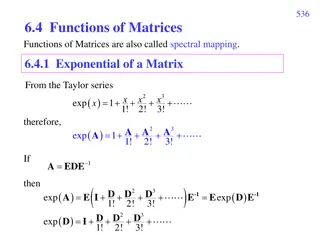Understanding the Rank of a Matrix and Calculation Methods
The rank of a matrix is crucial in linear algebra, indicating the number of linearly independent rows or columns. Learn about the concept, calculation methods like minor method and echelon form, and practical examples in this informative guide.
Download Presentation

Please find below an Image/Link to download the presentation.
The content on the website is provided AS IS for your information and personal use only. It may not be sold, licensed, or shared on other websites without obtaining consent from the author. Download presentation by click this link. If you encounter any issues during the download, it is possible that the publisher has removed the file from their server.
E N D
Presentation Transcript
RANK OF A MATRIX CHAPTER 3
The rank of a matrix is equal to the number of linearly independent rows (or columns) in it. Hence, it cannot more than its number of rows and columns. For example, if we consider the identity matrix of order 3 3, all its rows (or columns) are linearly independent and hence its rank is 3. RANK OF A MATRIX
The rank of a matrix can be found using three methods. The most easiest of these methods is "converting matrix into echelon form". HOW TO FIND THE RANK OF A MATRIX? Minor method Using echelon form Using normal form Let us study each of these methods in detail.
Finding Rank of a Matrix by Minor Method Here are the steps to find the rank of a matrix A by the minor method. Find the determinant of A (if A is a square matrix). If det (A) 0, then the rank of A = order of A. If either det A = 0 (in case of a square matrix) or A is a rectangular matrix, then see whether there exists any minor of maximum possible order is non-zero. If there exists such non-zero minor, then rank of A = order of that particular minor. Repeat the above step if all the minors of the order considered in the above step are zeros and then try to find a non-zero minor of order that is 1 less than the order from the above step. Here is an example. Example: Find the rank of the matrix (A) if A = . Solution: A is a square matrix and so we can find its determinant. det (A) = 1 (45 - 48) - 2 (36 - 42) + 3 (32 - 35) = -3 + 12 - 9 = 0 So (A) order of the matrix. i.e., (A) 3. Now, we will see whether we can find any non-zero minor of order 2. = 5 - 8 = -3 0. So there exists a minor of order 2 (or 2 2) which is non-zero. So the rank of A, (A) = 2.
Rank of a Matrix Using Echelon Form In the above example, what if the first minor of order 2 2 that we found was zero? We had to find all possible minors of order 2 2 until we get a non-zero minor to make sure that the rank is 2. This process may be tedious if the order of the matrix is a bigger number. To make the process of finding the rank of a matrix easier, we can convert it into Echelon form. A matrix 'A' is said to be in Echelon form if it is either in upper triangular form or in lower triangular form. We can use elementary row/column transformations and convert the matrix into Echelon form. A row (or column) transformation can be one of the following: Interchanging two rows. Multiplying a row by a scalar. Multiplying a row by a scalar and then adding it to the other row. Here are the steps to find the rank of a matrix. A row (or column) transformation can be one of the following: Interchanging two rows. Multiplying a row by a scalar. Multiplying a row by a scalar and then adding it to the other row. Here are the steps to find the rank of a matrix. Convert the matrix into Echelon form using row/column transformations. Then the rank of the matrix is equal to the number of non-zero rows in the resultant matrix.
Elementary transformations are operations done on the rows and columns of matrices to change their shape so that the computations become easier. It is also used to discover the inverse of a matrix, the determinants of a matrix, and to solve a system of linear equations. A square matrix is always an elementary matrix. Remember the row operations defined in. Any elementary matrix, denoted by E, is produced by performing the one-row operation on the identity matrix of the same size. ELEMENTARY TRANSFORMATIONS We determine a matrix's rank by the number of linearly independent columns it contains (or rows). A null matrix has no non-zero rows or columns. As a result, no separate rows or columns exist. As a result, a null matrix has a rank of zero. A matrix that differs from the identity matrix by one elementary row operation is called an elementary matrix. The left multiplication (pre-multiplication) of an elementary matrix represents primary row operations, whereas the right multiplication (post-multiplication) represents elementary column operations.
The fundamental transformation of matrices is critical. It may be used to locate analogous matrices as well as the inverse of a matrix. Playing with the rows and columns of a matrix is an example of elementary transformation. Elementary transformations can be of rows (elementary row operations) or columns (elementary column operations), but not both at the same time. Why do we do basic transformations?
EQUIVALENT MATRIX Equivalent Matrices are 2 matrices that have same size and shape. There are certain conditions that must be met for matrices to be equivalent (or equal) to each other. First of all, let s check the definition of equivalent matrices: Equivalent matrices are matrices whose dimension (or order) are same and corresponding elements within the matrices are equal.
NORMAL FORM OF A MATRIX A matrix A is said to be a Normal matrix if the pre and post matrix multiplication of conjugate transpose of A with the matrix A is commutative. In other words, normal matrices are those matrices whose matrix multiplication with its own conjugate transpose is commutative. Normal Matrix is a generalisation of Unitary, Hermitian, skew- Hermitian as well as symmetric and skew-symmetric matrices. A normal matrix is also unitarily diagonalizable, which means to diagonalize a normal matrix the required modal matrix is a unitary matrix. Let us define a normal matrix more formally in mathematical terms.























